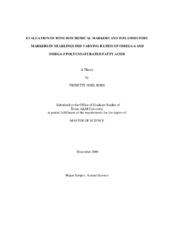| dc.description.abstract | Diets formulated to contain varying ratios of omega 6 to omega 3 fatty acids were
fed to exercising yearlings to evaluate bone activity and inflammatory response. Nine
Quarter Horse yearlings were arranged within a triplicated 3 X 3 Latin Square
experimental design and fed one of three diets. Exercise protocol was designed to
stimulate sub-clinical inflammation and normal bone response.
Body weight and physical growth measurements were not different between
groups (P > 0.05), and feed intake was similar between groups (P > 0.05).
Horses consuming soybean oil (SBO) diet had lower fatty acid profiles (% by
weight) of C16:0 and C16:1 (P < 0.05) when compared to horses consuming either corn
oil (CO) or menhaden/corn oil (MCO) diets. Though numerically different, percentage
changes in C16:0 and C16:1 were not different between diets (P < 0.05). Horses
consuming MCO had significantly higher measurements of C20:4, C20:5 and C22:6 over
the 28 day period when compared to horses consuming SBO or CO. Percent change in
mean concentrations of C20:5 were significantly different between the MCO group and the SBO group (P < 0.05) with no observed difference between MCO and CO treatment
groups.
Overall mean carboxyterminal telopeptide of type I collagen (ICTP)
concentrations did not differ between diets (P > 0.05) nor was there a significant change
from baseline values when compared to day 28 of the period.
Mean Osteocalcin (OC) concentrations did not differ between treatments (P >
0.05). Numerically, OC levels were lower after 14 days, with subsequent increases
occurring from day 14 to day 28; however, there was no significant day effect (P > 0.05).
Mean measurements of PGE2 and fibrinogen, the two inflammation markers
evaluated, did not differ among groups (P > 0.05). However, when fibrinogen data were
normalized, horses consuming SBO had a significantly lower change in baseline values
of fibrinogen compared to horses fed CO or MCO diets (P< 0.05).
In general, horses fed SBO exhibited reduced levels of the inflammatory marker
fibrinogen (P< 0.05). No other variable evaluated was influenced by the supplementation
of varying ratios of polyunsaturated fatty acids into the equine diet. | en |


